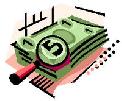
 |
|
| Financial Terms | |
| Purchase price |
|
Information about financial, finance, business, accounting, payroll, inventory, investment, money, inventory control, stock trading, financial advisor, tax advisor, credit.
Main Page: financial, financial advisor, stock trading, investment, credit, inventory control, inventory, accounting, |
Definition of Purchase price
Purchase priceprice actually paid for a security. Typically the purchase
Related Terms:Bargain-purchase-price optionGives the lessee the option to purchase the asset at a price below fair market Drop, theWith the dollar roll transaction the difference between the sale price of a mortgage-backed passthrough, GoodwillExcess of the purchase price over the fair market value of the net assets acquired under purchase Purchase accountingMethod of accounting for a merger in which the acquirer is treated as having purchased Residual methodA method of allocating the purchase price for the acquisition of another firm among the Sales chargeThe fee charged by a mutual fund when purchasing shares, usually payable as a commission to Take-or-pay contractA contract that obligates the purchaser to take any product that is offered to it (and pay  Cost basisAn asset’s purchase price, plus costs associated with the purchase, like installation fees, taxes, etc. Cost of salesThe manufacture or purchase price of goods sold in a period or the cost of providing a service. Yield a. Measure of return on an investment, stated as a percentage of price. Capital gainThe gain recognized on the sale of a capital item (fixed asset), calculated CapitalizeA purchase that has been recorded on the company books as an asset. The Purchase methodAn accounting method used to combine the financial statements of Section 83(b) ElectionThe decision by an employee to recognize taxable income Insured MortgageAn insured mortgage protects only the mortgage lender in case you do not make your mortgage payments. This coverage is provided by CMHC [Canada Mortgage and Housing Corporation] and is required if a person has a high-ratio mortgage. [A mortgage is high-ratio if the amount borrowed is more than 75% of the purchase price or appraised value, whichever is less.] Mortgage InsuranceCommonly sold in the form of reducing term life insurance by lending institutions, this is life insurance with a death benefit reducing to zero over a specific period of time, usually 20 to 25 years. In most instances, the cost of coverage remains level, while the death benefit continues to decline. Re-stated, the cost of this kind of insurance is actually increasing since less death benefit is paid as the outstanding mortgage balance decreases while the cost remains the same. Lending institutions are the most popular sources for this kind of coverage because it is usually sold during the purchase of a new mortgage. The untrained institution mortgage sales person often gives the impression that this is the only place mortgage insurance can be purchased but it is more efficiently purchased at a lower cost and with more flexibility, directly from traditional life insurance companies. No matter where it is purchased, the reducing term insurance death benefit reduces over a set period of years. Most consumers are up-sizing their residences, not down-sizing, so it is likely that more coverage is required as years pass, rather than less coverage.  Arm's length priceThe price at which a willing buyer and a willing unrelated seller would freely agree to Ask priceA dealer's price to sell a security; also called the offer price. Basis priceprice expressed in terms of yield to maturity or annual rate of return. Bid priceThis is the quoted bid, or the highest price an investor is willing to pay to buy a security. Practically Call priceThe price, specified at issuance, at which the issuer of a bond may retire part of the bond at a Call priceThe price for which a bond can be repaid before maturity under a call provision. Clean priceBond price excluding accrued interest. Closing purchaseA transaction in which the purchaser's intention is to reduce or eliminate a short position in Consumer Price Index (CPI)The CPI, as it is called, measures the prices of consumer goods and services and is a Conversion parity priceRelated:Market conversion price Convertible priceThe contractually specified price per share at which a convertible security can be  Delivery priceThe price fixed by the Clearing house at which deliveries on futures are in invoiced; also the Devaluation A decrease in the spot price of the currency
Direct stock-purchase programsThe purchase by investors of securities directly from the issuer. Dirty priceBond price including accrued interest, i.e., the price paid by the bond buyer. Dollar price of a bondPercentage of face value at which a bond is quoted. Effective call priceThe strike price in an optional redemption provision plus the accrued interest to the Equilibrium market price of riskThe slope of the capital market line (CML). Since the CML represents the Exercise priceThe price at which the underlying future or options contract may be bought or sold. Fair market priceAmount at which an asset would change hands between two parties, both having Fair priceThe equilibrium price for futures contracts. Also called the theoretical futures price, which equals Fair price provisionSee:appraisal rights. Fixed price basisAn offering of securities at a fixed price. Fixed-price tender offerA one-time offer to purchase a stated number of shares at a stated fixed price, Flat price riskTaking a position either long or short that does not involve spreading. Flat price (also clean price)The quoted newspaper price of a bond that does not include accrued interest. Full priceAlso called dirty price, the price of a bond including accrued interest. Related: flat price. Futures priceThe price at which the parties to a futures contract agree to transact on the settlement date. High priceThe highest (intraday) price of a stock over the past 52 weeks, adjusted for any stock splits. Invoice priceThe price that the buyer of a futures contract must pay the seller when a Treasury Bond is delivered. Law of one priceAn economic rule stating that a given security must have the same price regardless of the Limit priceMaximum price fluctuation Low priceThis is the day's lowest price of a security that has changed hands between a buyer and a seller. Low price-earnings ratio effectThe tendency of portfolios of stocks with a low price-earnings ratio to Limit priceMaximum price fluctuation Market conversion priceAlso called conversion parity price, the price that an investor effectively pays for Market price of riskA measure of the extra return, or risk premium, that investors demand to bear risk. The Market pricesThe amount of money that a willing buyer pays to acquire something from a willing seller, Marketplace price efficiencyThe degree to which the prices of assets reflect the available marketplace Maximum price fluctuationThe maximum amount the contract price can change, up or down, during one Minimum price fluctuationSmallest increment of price movement possible in trading a given contract. Also Minimum purchasesFor mutual funds, the amount required to open a new account (Minimum Initial Money purchase planA defined benefit contribution plan in which the participant contributes some part and Nominal priceprice quotations on futures for a period in which no actual trading took place. Open-market purchase operationA systematic program of repurchasing shares of stock in market Opening priceThe range of prices at which the first bids and offers were made or first transactions were Opening purchaseA transaction in which the purchaser's intention is to create or increase a long position in Option priceAlso called the option premium, the price paid by the buyer of the options contract for the right Price/book ratioCompares a stock's market value to the value of total assets less total liabilities (book Price/earnings ratio (PE ratio)Shows the "multiple" of earnings at which a stock sells. Determined by dividing current Price/sales ratio (PS Ratio)Determined by dividing current stock price by revenue per share (adjusted for stock splits). Price compressionThe limitation of the price appreciation potential for a callable bond in a declining interest Price discovery processThe process of determining the prices of the assets in the marketplace through the Price elasticitiesThe percentage change in the quantity divided by the percentage change in the price. Price impact costsRelated: market impact costs Price momentumRelated: Relative strength Price persistenceRelated: Relative strength Price riskThe risk that the value of a security (or a portfolio) will decline in the future. Or, a type of Price takersIndividuals who respond to rates and prices by acting as though they have no influence on them. Priced outThe market has already incorporated information, such as a low dividend, into the price of a stock. Price value of a basis point (PVBP)Also called the dollar value of a basis point, a measure of the change in Pricesprice of a share of common stock on the date shown. Highs and lows are based on the highest and Price-specie-flow mechanismAdjustment mechanism under the classical gold standard whereby Price-volume relationshipA relationship espoused by some technical analysts that signals continuing rises PurchaseTo buy, to be long, to have an ownership position. Purchase agreementAs used in connection with project financing, an agreement to purchase a specific Purchase and saleA method of securities distribution in which the securities firm purchases the securities Purchase fundResembles a sinking fund except that money is used only to purchase bonds if they are selling Purchase methodAccounting for an acquisition using market value for the consolidation of the two entities' Put priceThe price at which the asset will be sold if a put option is exercised. Also called the strike or Repurchase agreementAn agreement with a commitment by the seller (dealer) to buy a security back from Repurchase of stockDevice to pay cash to firm's shareholders that provides more preferable tax treatment Reverse price riskA type of mortgage-pipeline risk that occurs when a lender commits to sell loans to an Settlement priceA figure determined by the closing range which is used to calculate gains and losses in Share repurchaseProgram by which a corporation buys back its own shares in the open market. It is usually Spot priceThe current marketprice of the actual physical commodity. Also called cash price. Stated conversion priceAt the time of issuance of a convertible security, the price the issuer effectively Stock repurchaseA firm's repurchase of outstanding shares of its common stock. Strike priceThe stated price per share for which underlying stock may be purchased (in the case of a call) or Subscription priceprice that the existing shareholders are allowed to pay for a share of stock in a rights offering. Targeted repurchaseThe firm buys back its own stock from a potential bidder, usually at a substantial Theoretical futures priceAlso called the fair price, the equilibrium futures price. Transfer priceThe price at which one unit of a firm sells goods or services to another unit of the same firm. Related to : financial, finance, business, accounting, payroll, inventory, investment, money, inventory control, stock trading, financial advisor, tax advisor, credit. |